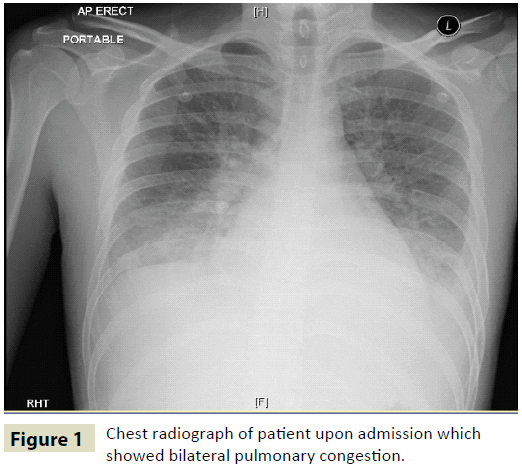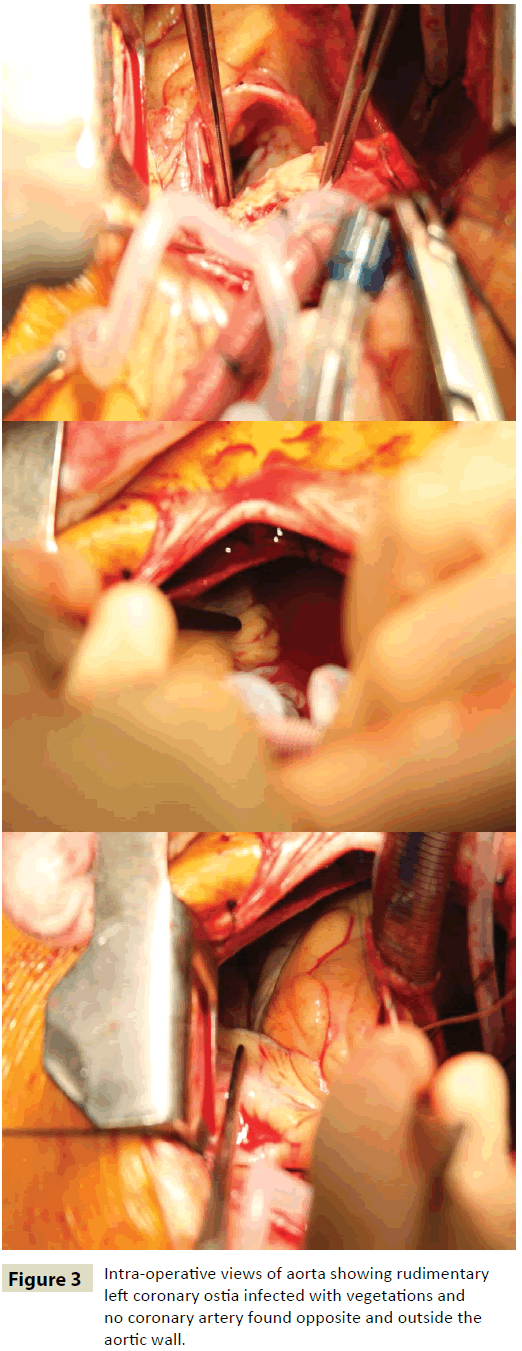Minimally Invasive Modified Bentall Operation in a Young Chinese Male with Severe Aortic Regurgitation Secondary to Infective Endocarditis in the Background of Bicuspid Aortic Valve Having a Rudimentary Coronary Ostia: A Case Report
Chih Chiang Nieh, Faizus Sazzad, Giap Swee Kang and Theodoros Kofidis
DOI10.21767/2577-0578.10007
Chih Chiang Nieh*, Faizus Sazzad, Giap Swee Kang, Theodoros Kofidis
Department of Cardiothoracic and Vascular Surgery, National University Hospital, Singapore
- *Corresponding Author:
- Chih Chiang Nieh
Department of Cardiothoracic and Vascular Surgery
National University Hospital, Singapore
Tel: 64722000
E-mail: chihchiang.nieh@gmail.com
Received date: October 02, 2015; Accepted date: November 07, 2015; Published date: November 17, 2015
Citation: Nieh CC (2015) Minimally Invasive Modified Bentall Operation in a Young Chinese Male with Severe Aortic Regurgitation Secondary to Infective Endocarditis in the Background of Bicuspid Aortic Valve Having a Rudimentary Coronary Ostia: A Case Report. Insights Chest Dis. 1:7.
Abstract
Objective: To describe the first case of minimally invasive modified Bentall Operation done at our institution that resulted in an excellent outcome.
Method: We describe a 28 year old Chinese male, without past medical history and risk factors, who presented with sudden shortness of breath on exertion associated with one month duration of lethargy and intermittent fever and was diagnosed with severe aortic regurgitation secondary to infective endocarditis on echocardiography. He was planned for a minimally invasive aortic valve replacement. Intra-operatively, the aortic wall was noted to be infected with vegetation in the background of bicuspid aortic valve and decision was made on table to perform minimally invasive modified Bentall Operation. He was also noted to have a rare presentation of rudimentary left coronary ostia, with only single right coronary ostia which supplies to the 3 coronary arteries.
Results: The patient had an uncomplicated clinical course post-operatively and was discharged on post-operative day five in excellent condition. He was started on life-long anticoagulation. The patient was asymptomatic on follow-up and is progressing well.
Conclusion: The initial surgical plan was for minimally invasive aortic valve replacement, but it was a decision made on table that changed to a minimally invasive modified Bentall Operation. The patient subsequently did well and benefitted from the advantages of a minimally invasive heart surgery.
Keywords
Case report; Aortic valve; Cardiac surgery; Bentall; Minimally-invasive
Introduction
The rationale for minimally invasive approaches to aortic valve surgery is to achieve several benefits such as smaller incisional scar resulting in superior cosmetic results, shorter hospital length of stay, decreased risk of sternal wound infection, early sternal stability, and reduction in post-operative pain.
We now demonstrate a recent case of a young Chinese male with severe aortic regurgitation secondary to infective endocarditis that had undergone a minimally invasive modified Bentall Operation procedure and had an excellent outcome.
Case
Patient is a 28 year old Chinese male without significant past medical history, presented with sudden shortness of breath on exertion, associated with one month duration of lethargy and intermittent fever, loss of appetite, loss of weight and reduced in effort tolerance. He also complained of productive cough, paroxysmal nocturnal dyspnoea and orthopnoea. There was no chest pain, diaphoresis, palpitations, lower limb swelling, urinary symptoms, abdominal pain, melena, rectal bleeding. His travel history was also unremarkable. In addition, he denies any high risk sexual behaviour, intravenous drug abuse and is neither on any traditional Chinese medication nor any immunosuppressants. He also does not have a history of any congenital heart problem.
His hemoglobin level was 8.0 g/dl and was transfused 2 pints of packed cells. His chest radiograph showed bilateral pulmonary congestion and was started on intravenous frusemide (Figure 1 and 2).
Cardiology consultation was made, and an urgent bedside transthoracic echocardiography was performed which showed severe aortic regurgitation, flail, non-coapt with vegetations. The patient was then started on intravenous antibiotics and infectious disease team was consulted. His blood culture upon admission subsequently grew streptococcus mitis. Dental review was also done which showed generalised moderate gingivitis. After 3 days of medical optimisation, patient was taken to the operating room where he was planned for minimally invasive mechanical aortic valve replacement.
On table, a mini-sternotomy from manubrium to the fourth intercostals space was performed. Intra-operatively, a dilated heart with moderately high pulmonary arterial pressure was noted. There was pericardial effusion with serious fluid of around 200 ml. The ascending aorta was of normal diameter and calibre and left ventricular function was moderate around 40% based on intra-operative transesophageal echocardiography.
A biscupid aortic valve with opening line at first and seven o’clock position was seen. There were rudimentary left coronary ostia with vegetation. Left main and right coronary artery was seen arising from the large right coronary ostia that were confirmed by a probe. The only single right coronary ostia supples the three coronary arteries. The aortic valve was seen with a significant chunk of vegetation causing severe aortic regurgitation but annulus was normal. Anterior mitral leaflet and left ventricle were normal. Decision was made to convert to modify Bentall procedure with replacement of ascending aorta together with aortic valve in view of coronary ostia findings. Direct antegrade cardioplegia of 1.5 L was given into the right coronary ostia and subsequently 500ml given every 20 minutes. The right coronary button was dissected using infra-annular 18 pledgetted sutures. Medtronic ATS aortic valve grade size 25 mm was inserted after sizing and the single coronary button anastomosis done using prolene 6/0 suture. Distal anastomosis was done with 3/0 prolene with Teflon felt and reinforced with prolene 4/0. Procedure was uneventful and a chest tube was inserted in the mediastinum and two other chest tubes separately into left and right pleura respectively externally.
Patient was then transferred to cardiothoracic intensive care unit post-operatively, started on life-long anticoagulation and subsequently was discharged well on fifth operative day with outpatient antibiotics therapy via peripherally inserted central catheter (Figure 3 and 4).
The patient denied any complaints at follow-up and has continued to progress well.
Discussion
Studies have shown that minimally invasive approach, in this case, a “J’ incision into the fourth inter-costal space [1,2], may improve cosmetic results [3] and shorter intensive care unit stay [4]. On the other hand, the surgery becomes more technically demanding in view of limited visualisation in the Bentall procedure which requires three-dimensional spatial orientation. Furthermore, Bentall operation is preferred over isolated aortic valve replacement in the case of extensive involvement of aortic root with vegetation [5,6] and especially in the background of bicuspid aortic valve.
Conclusion
The initial surgical plan was for a minimally invasive aortic valve replacement, but it was an on-table decision that changed to a minimally invasive modified Bentall operation in view of the aortic wall infected with vegetation in the background of bicuspid aortic valve and patient subsequently did well and benefitted from the advantages of minimally invasive heart surgery. Thus, we recommend minimally invasive approach for patient who is younger and less co-morbidities.
Acknowledgement
We would like to thank the NUH perfusionist team and everyone who had been assisting us in the management of the patient.
Disclosure
The authors declare no conflict of interest.
References
- Brown ML, McKellar SH, Sundt TM, Schaff HV (2009) Ministernotomy versus conventional sternotomy for aortic valve replacement: systematic review and meta-analysis. J ThoracCardiovasSurg 137:670-679.
- Plass A, Scheffel H, Alkadhi H, Kaufmann P, Genoni M, et al. (2009) Aortic valve replacement through a minimally invasive approach: preoperative planning, surgical technique, and outcome. Ann ThoracSurg88:1851-1856.
- Szwerc MF, Benckart DH, Wiechmann RJ,Savage EB, Szydlowski GW, et al. (1999) Partial versus full sternotomy for aortic valve replacement. Ann ThoracSurg 68:2209.
- Khosbin E, Prayaga S, Kinsella J, Sutherland FW (2011) Mini-sternotomy for aortic valve replacement reduces the length of stay in the cardiac intensive care unit: meta-analysis of randomised controlled trials. BMJ Open; 1:e000266.
- Gunlins H, Kiliam E, Roth S, Uhlig A, Kreuzer E, et al. (2002) Is there an advantage in using homografts in patients with acute infective endocarditis of the aortic valve? J Heart Valve Dis11:492-497.
- Avierinos JF, Thuny F, Chalvignac V,Giorgi R, Tafanelli L, et al. (2007) Surgical treatment of active aortic endocarditis homografts are not the cornerstone of outcome. Ann ThoracSurg84:1935-1942.
Open Access Journals
- Aquaculture & Veterinary Science
- Chemistry & Chemical Sciences
- Clinical Sciences
- Engineering
- General Science
- Genetics & Molecular Biology
- Health Care & Nursing
- Immunology & Microbiology
- Materials Science
- Mathematics & Physics
- Medical Sciences
- Neurology & Psychiatry
- Oncology & Cancer Science
- Pharmaceutical Sciences




